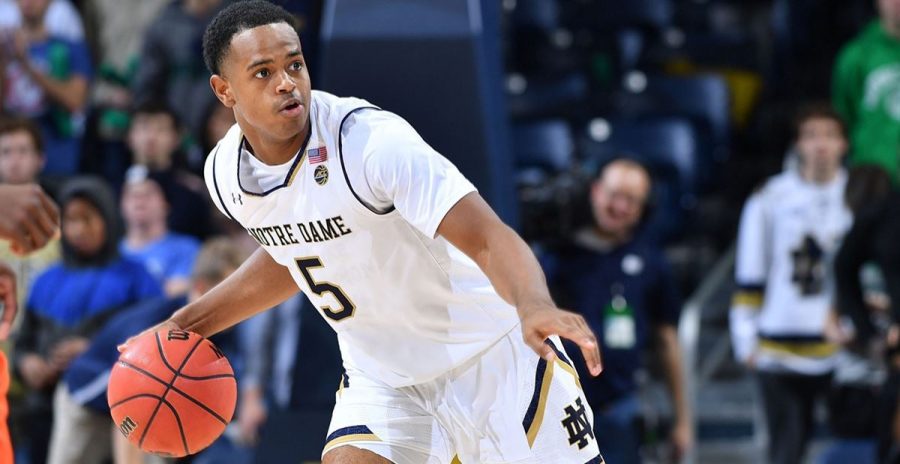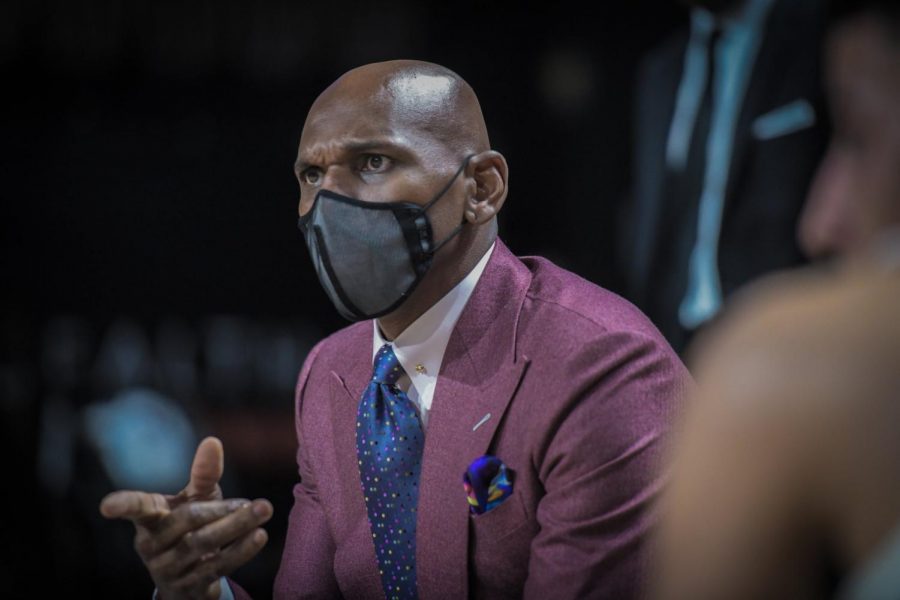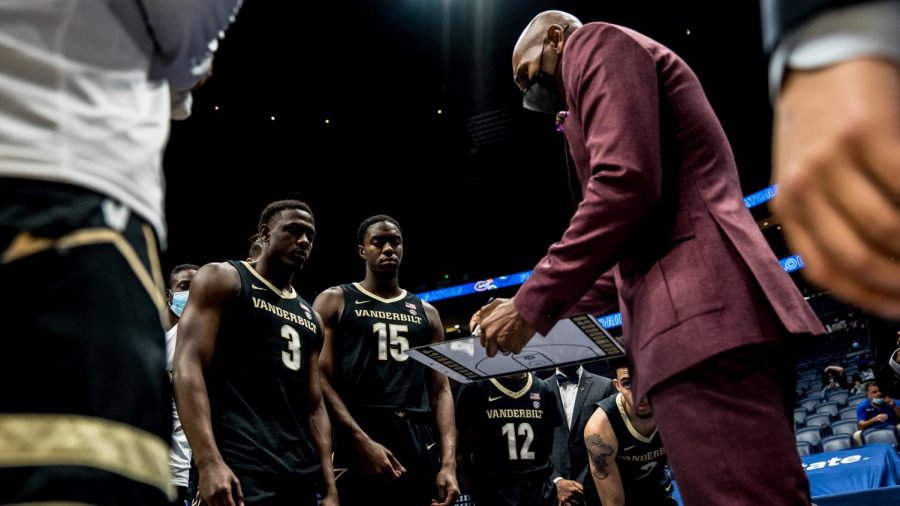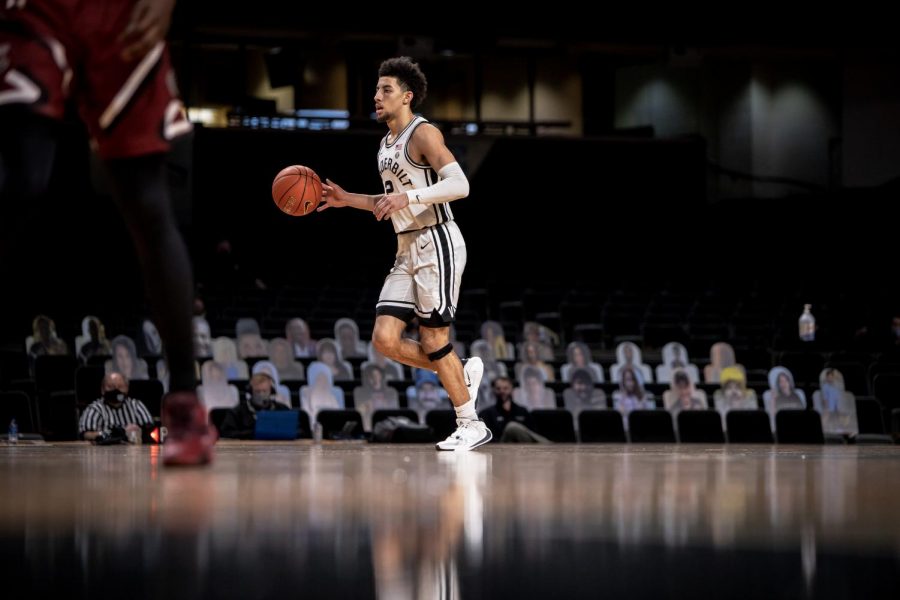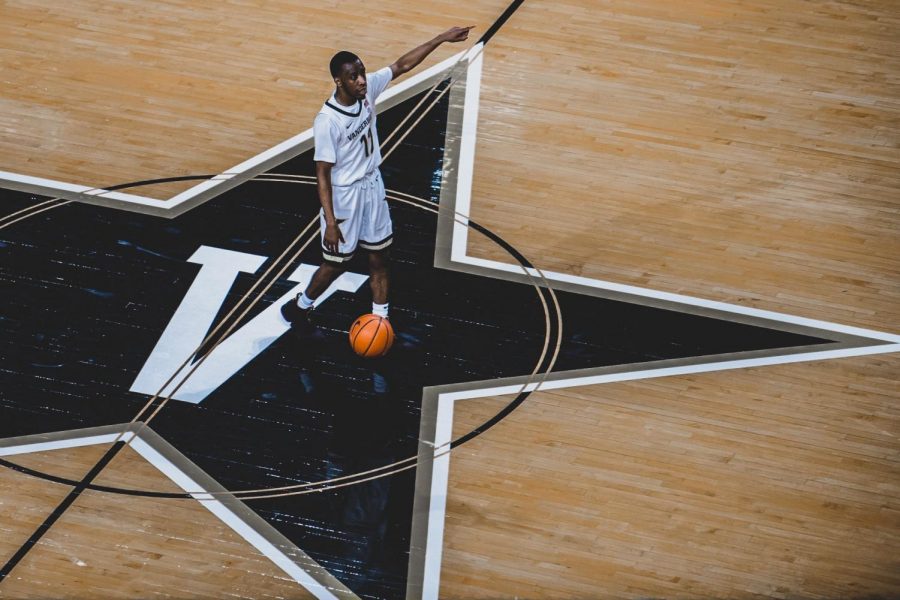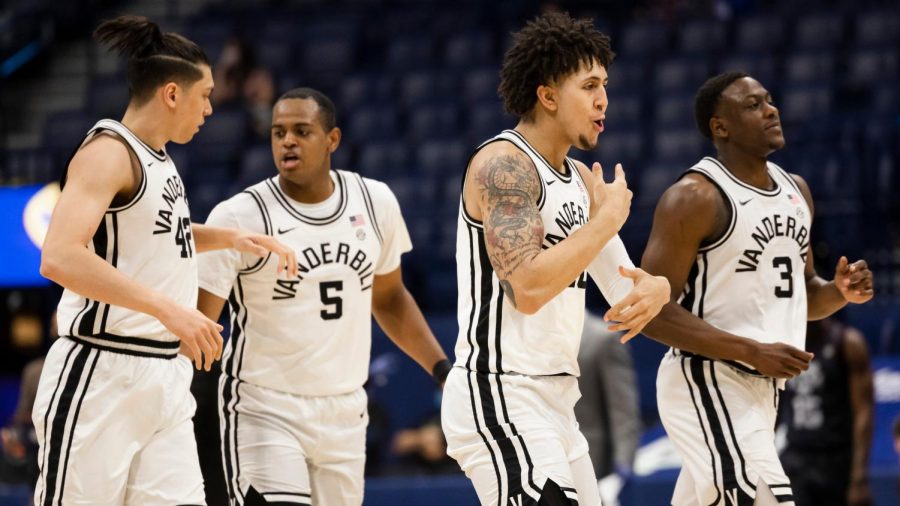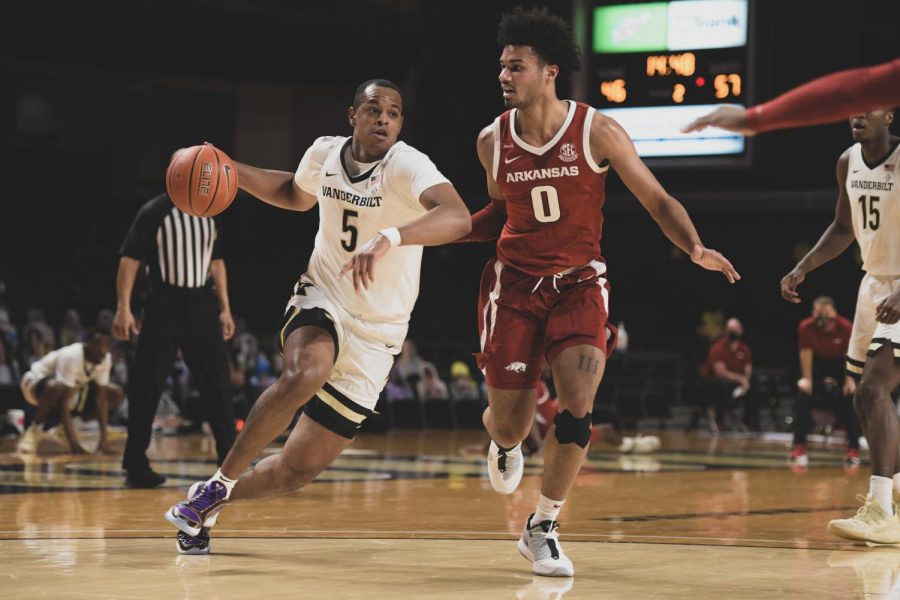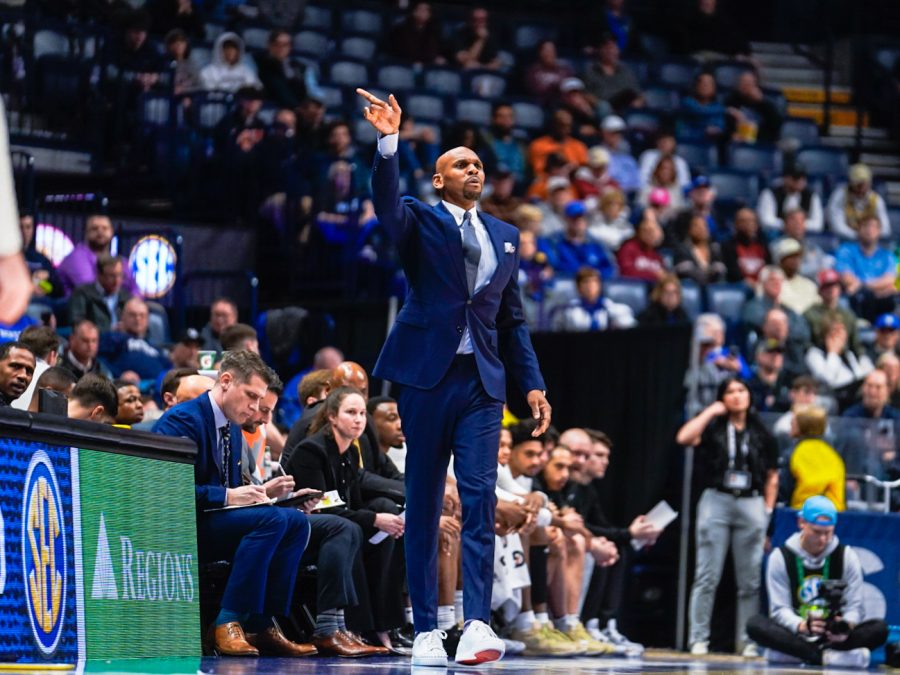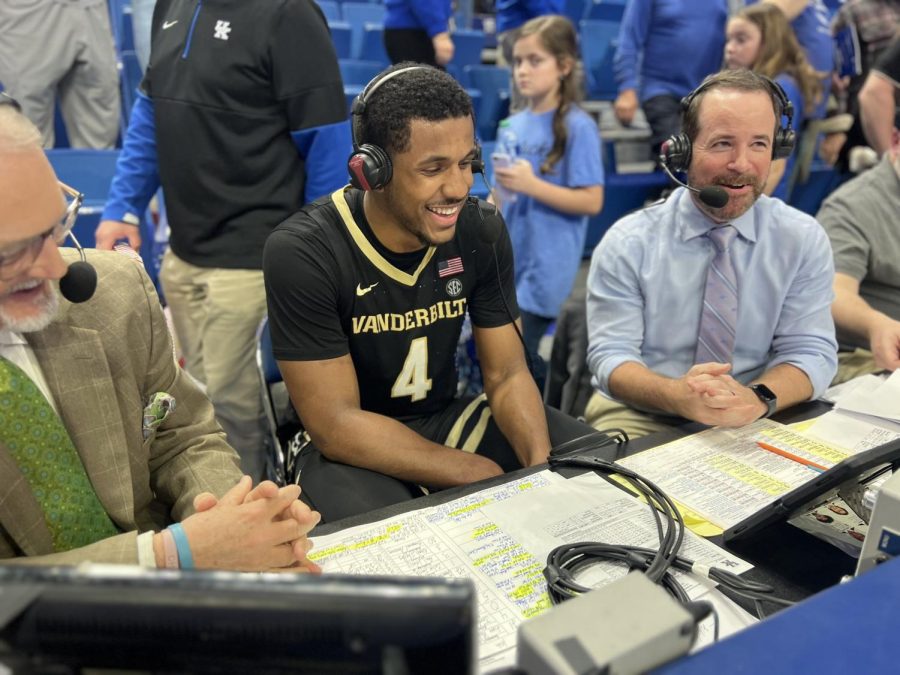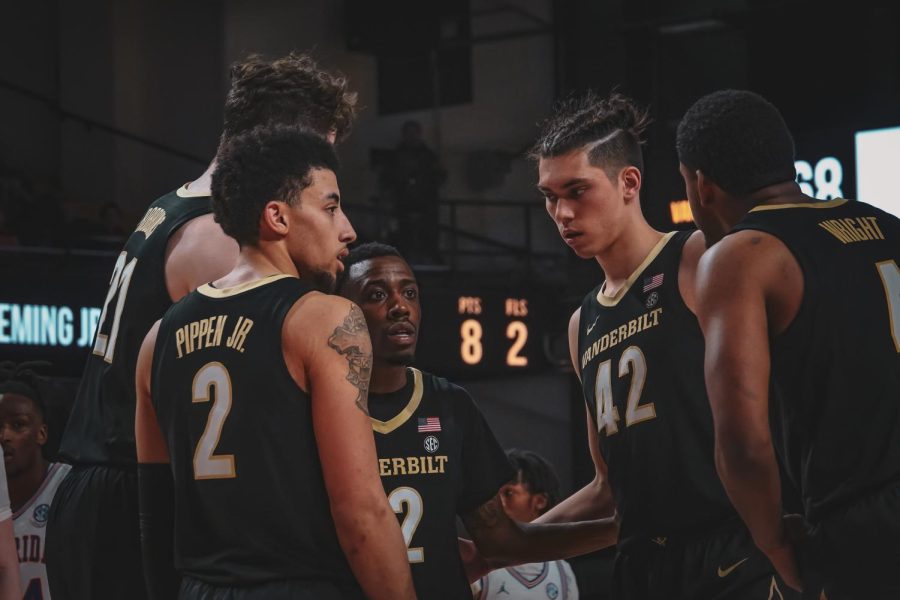Following the departure of stars Aaron Nesmith and Saben Lee, head coach Jerry Stackhouse finds his team in need of offense.
Nesmith, a recent lottery pick in the NBA Draft, and Lee, an All-SEC performer and recent second round pick, averaged 23 and 18.6 points per game, respectively. And their combined 916 total points represented nearly 40% of the Commodores’ total offensive production in the 2019-2020 season.
Needless to say, with roughly 42 points per game up for grabs, Stackhouse will be searching for scoring. And the good news for the second-year head coach is that, in his first major move as head coach on West End, he pried former 4-star recruit, DJ Harvey, away from Notre Dame via the transfer market.
Stackhouse has been eagerly waiting to use Harvey in his creative, NBA-style offense, and he has placed large expectations on the 6’6” junior.
“We are counting on him to kind of fill that role somewhat that Aaron filled for us, a guy that can come off of screens and shoot,” Stackhouse told the media on Oct. 15. “But I think he just has maybe a little bit better ball-handling and playmaking ability that we want to take advantage of.”
Nesmith’s three-point shooting truly carried the Commodores scoring last season, and without that lethal threat, fans should prepare for the offense to look slightly different this season with Harvey as its catalyst.
Make no mistake: the three-point shot will still be a driving force behind this offense. Nearly 45% of Vanderbilt’s shot attempts were from three last season, good for 35th nationally. But this year, they will have an offensive centerpiece more well-rounded than Lee and Nesmith and that will open the offense tremendously for secondary playmakers such as Scotty Pippen Jr. and Dylan Disu.
A Three-Level Scorer
It has been quite a few years since Vanderbilt has had a true three-level scorer, but parts of Harvey’s game will remind Commodore fans of the last one they witnessed: Jeff Roberson.
With similar 6’6” bodies, Harvey and Roberson can both be bulldozing guards on the inside, balanced mid-range scorers, and three-point threats on the perimeter.
But what Harvey will add is a touch of ball-handling that neither Roberson nor Nesmith had. His handle is what truly brings his full offensive package together. It allows him to get nearly anywhere on the floor and makes him a constant threat for pull up jumpers and drives.
Harvey has a big frame and underrated mid-range game that, when matched up on smaller guards, will allow him to create offense in the low post via turnaround jumpers and simple post ups. He has a crafty turnaround jump shot and uses his length to create just enough space to get mid-range shots up over defenders.
But when matched up on larger forwards, he will be able to use his tight handle and quickness to take larger defenders off the dribble as shown below.
However, Harvey’s main source of production figures to come from the perimeter via pull up jumpers from both inside and outside the three-point line. As demonstrated below, Harvey can create his own shot at will by quickly picking up his dribble and transitioning into a shooting motion. He elevates beautifully and has a high release that, in conjunction with his handle, enables him to quickly rise up above defenders.
In his sophomore season at Notre Dame, Harvey shot a measly 39% from the field and only 30% from three-point range. But during his two years in South Bend, 44% of his shots were from three-point range.
It is no secret that Stackhouse wants his team shooting threes, and following an offseason in which he most certainly worked on his three point efficiency, Harvey will be able to use his already refined fundamentals in Stackhouse’s three-point heavy offense.
There are noticeable comparisons in the clips above to former Vanderbilt sharpshooter Aaron Nesmith. And although Harvey will be used on the ball more than Nesmith, he is capable of running off of screens and shooting, something Stackhouse will most certainly incorporate into this year’s offense.
Harvey’s ability to score in the post, from mid-range, and from beyond the arc makes him a constant threat for which defenses must gameplan. This will open up the offense for Vanderbilt’s other starters, like Disu and Brown, to hit spot-up threes, and it will allow Pippen Jr. to be creative off the ball.
“I think D.J. Harvey is a guy that has been a primary scorer. We are looking for him to step in right away and be a primary scorer for us,” Stackhouse told the Hustler in April. “He can score at all three levels. He can shoot the three. He can post. He can drive, and he can be a facilitator as well.”
A Secondary Ball-Handler
Last season, Lee and Pippen Jr. combined for 248 assists, nearly 70% of the Commodores’ team assists. Stackhouse’s backcourt was among the best at producing quality shots in the Southeastern Conference (SEC).
Much of their success as a duo stemmed from one of them playing off the ball while the other demanded attention on the ball. For instance, when Lee played point guard, Pippen Jr. was free to roam about the offense and oftentimes found open three point shots because of it.
This year, without Lee, Stackhouse is searching for ways to get Pippen Jr. more touches off the ball so that he can capitalize on his spot up shooting ability. Pippen Jr. has a knack for being creative around screens, and with his small stature, it is difficult for opposing defenders to track around a motion offense.
He was efficient from beyond the arc during his freshman season (36.2%) but only attempted 2.9 threes per game. That is a number Stackhouse certainly wants to go up, and Harvey can help make it happen.
Stackhosue has mentioned multiple times that one of the biggest differences between Nesmith and Harvey is Harvey’s ability to put the ball on the floor. His ability to be the initiator of offense is going to be a weapon for this team, and it’s going to open up opportunities for Pippen Jr. and others to find open shots simply because of the attention that Harvey draws with his slashing.
He is frequently able to get into the lane off the drive and when he does not have an open shot, he is patient to wait for a cutter or find a shooter to kick out to. This patience stems from Harvey’s maturity and experience, other important elements he will bring to this team.
Although it was not his primary role at Notre Dame, Harvey showed flashes of being able to create for others. With the Commodore offense expected to run through him this year, don’t be surprised if Harvey fills the assist void left by Lee with simple playmaking like that shown above.
A Pick-and-Roll Threat
With his ability to score at all three levels and his impressive ball-handling skills, Harvey is an obvious candidate for dozens of pick-and-roll sets this season. The one NBA-style offensive set often missing from Stackhouse’s offense last season was the pick-and-roll, but Harvey will most certainly fill that need.
Although Lee had some success in pick-and-rolls last season, his inability to pull up from mid-range made him a more predictable threat off the screen. Harvey’s ability to create at all three levels makes him a difficult matchup when working off a screen.
As he shows in multiple clips above, Harvey is always looking to shoot off screens and can do so both off the hop or by stepping into his shot. Using a mix of hops and steps enables him to change speeds and keep defenders guessing.
When defenders travel under the screen or fail to get far enough out on him, he is comfortable pulling up over them with his elevation and quick trigger. But he also shows that he can take it all the way to the rim off a screen. He is not afraid to attack help defense and works downhill very nicely. Harvey averaged just over three free throws per game his last season at Notre Dame, but with more opportunity, this number may rise significantly this year at Vanderbilt.
With Clevon Brown’s fundamentals and the added size of Quinton Millora-Brown, the Commodores will have many options to pair Harvey with in the pick-and-roll. Brown and Harvey have the potential to work an efficient two-man game thanks to both players’ versatility. Brown can both roll to the rim or pop for a three pointer, and Harvey has the handle and vision to get the ball to him in the right spots or simply score off the screen himself.
Vanderbilt has several returning players set to take a step forward on the offensive side of the floor. But there is no doubt with Harvey’s dynamic offensive skill set, he will be the driving force behind this year’s offense. Not only will he be able to generate points on his own, but most importantly, he will be a constant focal point for opposing defenses, which will free up opportunities for other Commodores to help fill the void left by Lee and Nesmith.


